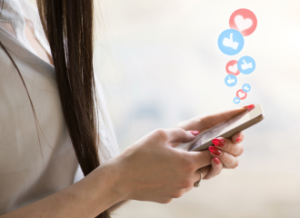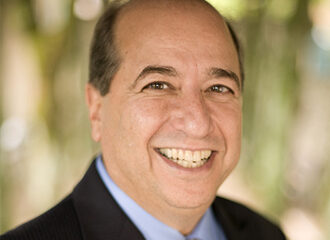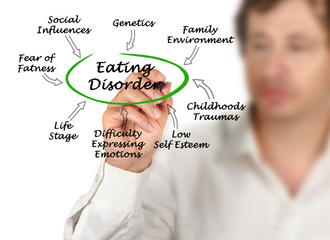Written by: Erin Birely, LCPC
Alumni Services Coordinator

Social media allows us to connect with a wider range of people and ideas than we may normally experience in our day to day lives. This can be both a blessing and a curse. For those of us who feel alone or misunderstood we can find the connection and belonging of knowing there are others out there “like us”.
But as much as social media can expose us to new ideas and perspectives that can help us think flexibly, acknowledge our implicit biases and work to change them—it can also pose significant challenges for those struggling with eating disorders.
The Dark Side of Social & Eating Disorders
The darker side of social media is that sometimes the ideas and beliefs we’re exposed to are hurting us more than they’re helping. Social media allows people to say things to others without the personal connection that comes when speaking face to face. This can allow people to promote harmful products or ideas that someone wouldn’t necessarily promote in-person.
Social media also allows people to feel protected from retribution due to the physical distance and anonymity of being behind a screen. In addition, the unrealistic expectations social media creates with filters, edits, poses, and accounts showcasing the highlights of someone’s life can add to the feeling of being othered or less than our “peers”. Despite seeing an increase in trends showing the reality of the moment, we still likely find ourselves comparing to that one shot of “perfection” while discounting the energy and effort it took to get it.
7 Ways Social Negatively Impacts Eating Disorders
All of the above negativity produces an environment that can be toxic for someone with an eating disorder. Here are some of the biggest challenges.
- Body Image Issues: Social media is filled with images of idealized bodies that may not be realistic, healthy. Constant exposure to these images can contribute to negative body image perceptions, which can be extremely harmful for someone struggling with or in recovery from an eating disorder.
- Comparison: Social media often encourages comparison between individuals, and someone with an eating disorder may feel the need to measure up to perceived societal standards. This can exacerbate feelings of inadequacy and trigger unhealthy behaviors.
- Cyberbullying: Negative comments, body shaming, or cyberbullying are sadly all too common on social platforms. Individuals with eating disorders are likely to be far more vulnerable to such comments, impacting their mental health and recovery process.
- Thinspiration & Pro-Eating Disorder Content: Unfortunately, some social media platforms have hosted content that promotes unhealthy weight loss behaviors or glorifies eating disorders. Navigating this type of content can be triggering and detrimental to individuals trying to overcome their struggles.
- Constant Connectivity: The constant connectivity of social media can be overwhelming and add stress to an individual’s life. The pressure to be constantly available, to keep up with trends, and to present a curated image of oneself can be stressful for anyone, and doubly so for someone with an eating disorder.
- Misinformation: Information spreads rapidly on social media. There is an ever-present risk of encountering inaccurate or harmful information related to dieting, nutrition, and body image, which can negatively influence someone’s approach to their eating disorder.
- Isolation & Social Withdrawal: While social media can connect people, it can also contribute to isolation. Constant exposure to others’ lives, especially when struggling with an eating disorder, can lead to negative thinking, feelings of inadequacy and overall withdrawal from social interactions.
4 Tips for Navigating the Negative Part of Social Media
So, with these two sides to social media, do we just throw the whole thing out? While that is possible, it can be difficult. This is especially challenging for the generations who grew up with social media and use it as their primary way of connecting and communicating. While the idea of turning back time might seem desirable, it isn’t necessarily realistic. Instead, it’s best to acknowledge the benefits of social media, work to amplify those positives, and try to reduce our exposure to the negative aspects. Now let’s talk about how we do this.
Increase Awareness
First step in increasing the positives while reducing the negatives is to become aware of what is in our feed. Many of us likely scroll through mindlessly without consciously thinking about what we’re exposing ourselves to. While we may not be aware of what we’re taking in, the algorithm most certainly is. Set a small goal that feels realistic to you. Try to practice mindful awareness for a set amount of time rather than mindlessly scrolling. Check in with yourself about how the content in your feed impacts your emotions, thoughts, and behaviors.
Interact with Positive Content
Now that you’ve increased your awareness, choose to interact more with the positive posts you’re seeing. Interacting might include liking, commenting, sharing, or saving the posts that lead to you feeling included, understood, or just amused and happy. When you come across posts that negatively impact you, try to report them if they’re harmful, or if they’re just not your taste, tap the dislike or “not interested” option that some social media platforms offer. These steps will teach the algorithm to provide you more of what you do want and less of what you don’t want. You can also search for and follow accounts that promote recovery, or funny accounts your friends recommend to help boost the positive content in your feed.
Set Limits
Another way to decrease the negative impact social media can have is to set limits on the amount of time spent on an app. Most phones will now allow you to set a time limit on the apps you use, and the feature will lock you out once you hit that limit. While this isn’t a foolproof system, it will at least be a reminder you’ve spent a significant amount of time on the app. The alert could increase your awareness and motivate you to take a break that you wouldn’t have normally taken. Additionally, creating limits around when and where you will and will not use social media (e.g., avoiding social media in bed or while eating) can also reduce your overall usage and your exposure to more harmful posts.
Take a Break
Sometimes you might find a longer break is most effective in reducing the impact of negative or harmful posts. Set a specific amount of time you want to be off social media and remove the apps from your home screen, so you aren’t tempted to go on. You can let others know you’re taking a break and see if anyone will join you in your mini social media vacation. This tactic can be especially helpful if you’re feeling overwhelmed currently by social media. Consider working with your treatment team or supports on building skills to tolerate the discomfort when you return. You can even ask a friend or support to help you curate your feed by blocking certain accounts and setting you up with new ones while you’re on your break.
Conclusion
As mentioned at the start, social media is here to stay for the foreseeable future, and that doesn’t have to be an entirely negative thing. It is about finding the connections through those platforms that support the goals we’re working towards. When you think about your social media account, ask yourself, “is this something that is in line with my values?” When it isn’t, maybe it’s a signal to create boundaries, set limits, take a break, or interact differently with it. Find the strategies that work best for you and repeat as necessary until your virtual spaces bring you a sense of connection, happiness, and peace.



